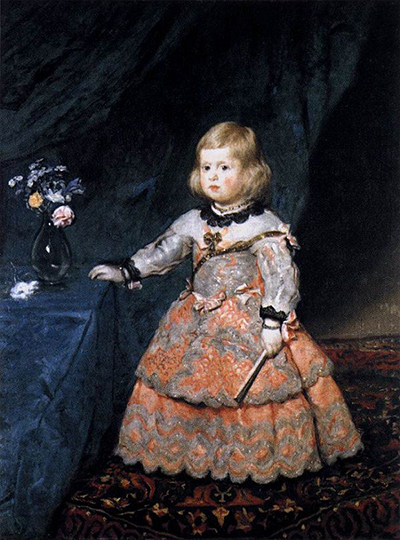Diego Velazquez was, first and foremost, a highly skilled portrait painter. He would also be fortunate in the subjects that he could paint, because of his impressive connections within Spanish and European society. The artwork displayed here is of Infanta Margarita from around 1653-1654.
This particular piece can be found in the Kunsthistorisches Museum in Vienna and is believed to have been one of five portraits that he painted of Margaret Teresa of Spain. The Kunsthistorisches Museum actually holds a good selection of the different portraits produced of this woman, helping us to visually compare her progress across a number of years. The item found here puts her in a peach dress and the richly coloured painting captures the red tones of her hair at the time. She stands upon a decorative carpet, whilst leaning on a table that has been covered by a beautiful blue cloth. There is also a glass vase with several flowers which adds a reflection of light from the left hand side. Behind her is a cloth that hangs across the entire background and attempts to avoid anything from that distracting our eyes too much, or unbalancing the foreground with some unwanted light or colour.
See also Infanta Margarita Teresa in a Blue Dress in which her outfit is larger and more glamorous, filling most of the scene. She would become an important figures within European history and features within the career of many notable artists, besides just Velazquez. She can also be found in the famous Las Meninas painting, which remains the Spanish painter's most celebrated work, positioned centrally within the composition, as the artist himself appears just over her left shoulder. Further notable portraits of her life would be produced by the likes of Jan Thomas van Ieperen, a respected a Flemish Baroque painter, as well as Juan Bautista Martínez del Mazo who was a Spanish member of the same movement. A further piece was contributed by Gerard Du Chateau as well. The 1959 portrait whilst wearing her blue dress probably remains the most famous artwork of the single portraits, partly because of the fame of Velazquez but also the way in which her dress dominates so memorably.
The Kunsthistorisches Museum in Vienna provides an exceptional survey of European art within its collection, with The Hunters in the Snow by Pieter Bruegel the Elder being amongst the most memorable of pieces. Adoration of the Trinity from 1511 by Albrecht Durer is also another prized possession, as is Madonna of the Meadow and St Margaret and the Dragon from Raphael. Those fortunate enough to visit this location will be able to spend many hours here, as still perhaps not have covered everything found here as their large collection cannot possibly all be on display at the same time, making it also worthwhile to make return visits from time to time, if that is possible.




